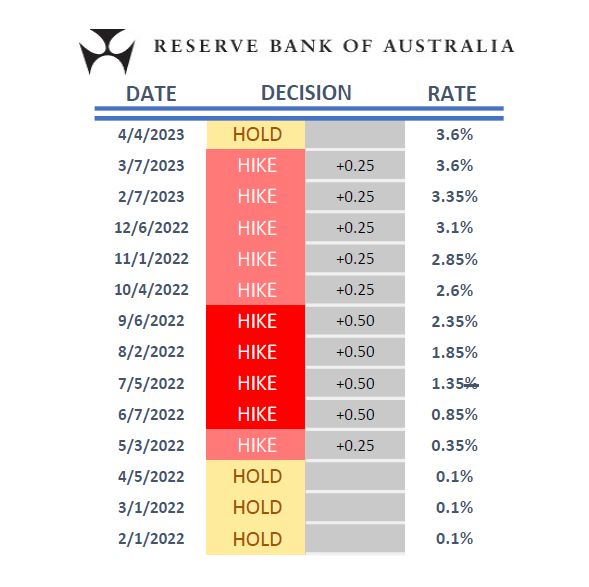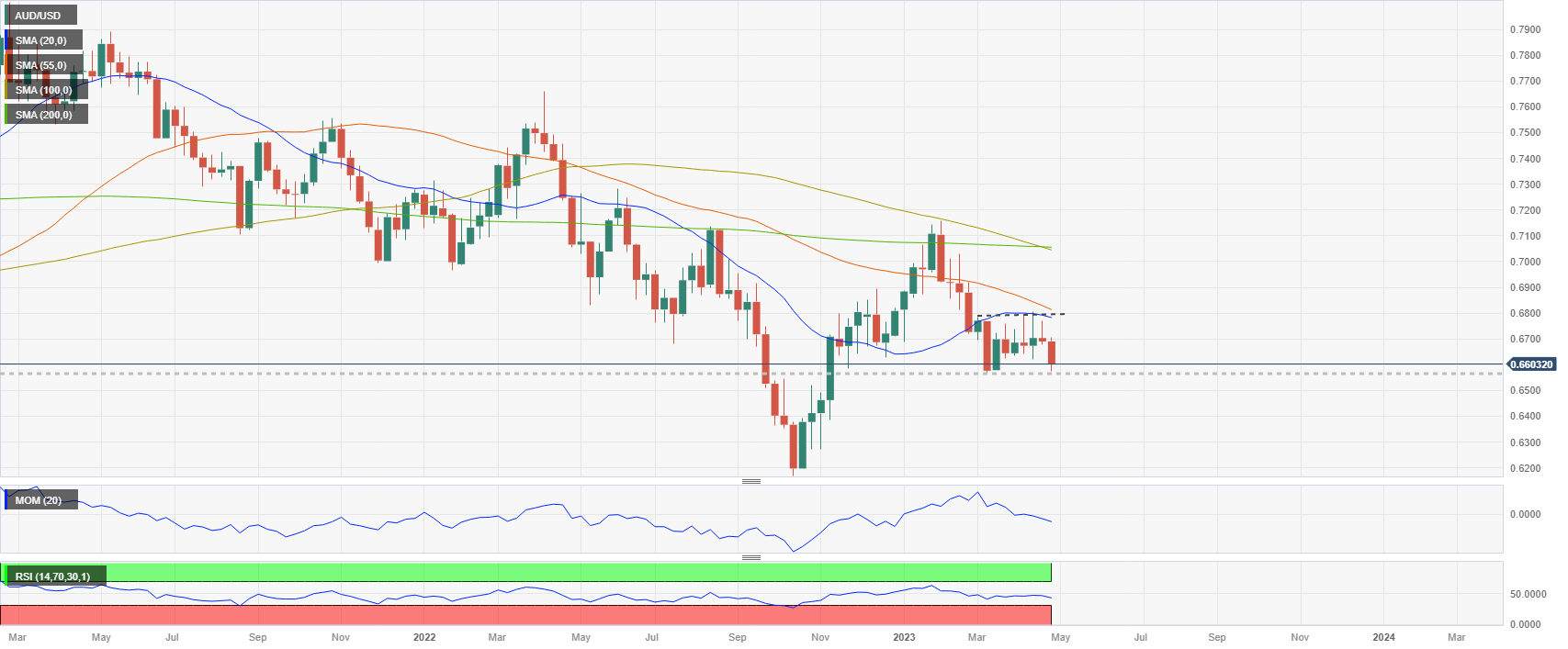- The Reserve Bank of Australia is set to leave the cash rate target unchanged at 3.60% to “assess the impact” of rate hikes.
- Friday's Statement on Monetary Policy could be more important than the meeting.
- The outlook for AUD/USD has deteriorated with the RBA's decision to pause.
The Reserve Bank of Australia (RBA) is expected to leave the cash rate target unchanged at 3.60% on May 2, following the decision made at the April meeting.
In April, the RBA stated, “The Board recognises that monetary policy operates with a lag and that the full effect of this substantial increase in interest rates is yet to be felt. The Board took the decision to hold interest rates steady this month to provide additional time to assess the impact of the increase in interest rates to date and the economic outlook”.
Since then, inflation has slowed further and economic data has been mixed. So the context warrants an extended pause. Market participants also anticipate the RBA will stay on hold. The central bank will continue to mention that it is ready to act if necessary, considering that inflation remains above the target. Rate-cut bets by the end of the year have been reduced. Incoming economic data will likely weigh on monetary policy expectations.
Inflation fell significantly during the first quarter but remains elevated. The Consumer Price Index dropped from 7.8% to 7.0%. The Producer Price Index fell in Q1 to 5.2% from 5.8%, the slowest pace since Q1 2022. The RBA expects inflation to continue its gradual decline. Only a change in this forecast could move the central bank from the “extended pause” it started in April.
On Friday, the RBA will publish its monetary policy statement. It is expected to downgrade inflation forecasts, in line with the extended pause decision. It will likely upgrade GDP growth forecasts. It will show how they see the economy and the outlook.
Tuesday’s RBA meeting will be the first one since the Review of the Reserve Bank of Australia. Governor Philip Lowe said the Board will consider the recommendation in the coming meetings.
AUD/USD and the RBA
The AUD/USD posted its lowest weekly close since early March and is testing levels under 0.6600, focusing on the year-to-date low at 0.6560/65. The Australian Dollar has lagged lately, driven by the RBA's pause, while other central banks are still raising interest rates, creating monetary divergence that weighs on the Aussie.
The pair seems to be vulnerable ahead of the RBA meeting. Not much impact is expected from the meeting. The central bank is likely to repeat the same message, leaving market participants with no new information. However, if the RBA suggests it could start hiking again soon, the Aussie could rally, at least until Friday's monetary statement. The signs of an extended pause ahead are what markets expect, so it should not significantly influence the AUD/USD.
The pair has accelerated to the downside. If it drops below the 0.6550 area, it has more room to decline. On the contrary, if it manages to remain above 0.6600, it could continue to move sideways between that level and 0.6770. A weekly close above 0.6800 should invalidate the bearish perspective.
Information on these pages contains forward-looking statements that involve risks and uncertainties. Markets and instruments profiled on this page are for informational purposes only and should not in any way come across as a recommendation to buy or sell in these assets. You should do your own thorough research before making any investment decisions. FXStreet does not in any way guarantee that this information is free from mistakes, errors, or material misstatements. It also does not guarantee that this information is of a timely nature. Investing in Open Markets involves a great deal of risk, including the loss of all or a portion of your investment, as well as emotional distress. All risks, losses and costs associated with investing, including total loss of principal, are your responsibility. The views and opinions expressed in this article are those of the authors and do not necessarily reflect the official policy or position of FXStreet nor its advertisers. The author will not be held responsible for information that is found at the end of links posted on this page.
If not otherwise explicitly mentioned in the body of the article, at the time of writing, the author has no position in any stock mentioned in this article and no business relationship with any company mentioned. The author has not received compensation for writing this article, other than from FXStreet.
FXStreet and the author do not provide personalized recommendations. The author makes no representations as to the accuracy, completeness, or suitability of this information. FXStreet and the author will not be liable for any errors, omissions or any losses, injuries or damages arising from this information and its display or use. Errors and omissions excepted.
The author and FXStreet are not registered investment advisors and nothing in this article is intended to be investment advice.
Recommended Content
Editors’ Picks

Gold trades near record-high, stays within a touching distance of $3,100
Gold clings to daily gains and trades near the record-high it set above $3,080 earlier in the day. Although the data from the US showed that core PCE inflation rose at a stronger pace than expected in February, it failed to boost the USD.

EUR/USD turns positive above 1.0800
The loss of momentum in the US Dollar allows some recovery in the risk-associated universe on Friday, encouraging EUR/USD to regain the 1.0800 barrier and beyond, or daily tops.

GBP/USD picks up pace and retests 1.2960
GBP/USD now capitalises on the Greenback's knee-jerk and advances to the area of daily peaks in the 1.2960-1.2970 band, helped at the same time by auspicious results from UK Retail Sales.

Donald Trump’s tariff policies set to increase market uncertainty and risk-off sentiment
US President Donald Trump’s tariff policies are expected to escalate market uncertainty and risk-off sentiment, with the Kobeissi Letter’s post on X this week cautioning that while markets may view the April 2 tariffs as the "end of uncertainty," it anticipates increased volatility.

US: Trump's 'Liberation day' – What to expect?
Trump has so far enacted tariff changes that have lifted the trade-weighted average tariff rate on all US imports by around 5.5-6.0%-points. While re-rerouting of trade will decrease the effectiveness of tariffs over time, the current level is already close to the highest since the second world war.

The Best brokers to trade EUR/USD
SPONSORED Discover the top brokers for trading EUR/USD in 2025. Our list features brokers with competitive spreads, fast execution, and powerful platforms. Whether you're a beginner or an expert, find the right partner to navigate the dynamic Forex market.

